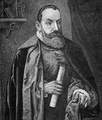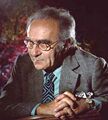Template:Selected anniversaries/August 22: Difference between revisions
Jump to navigation
Jump to search
No edit summary |
No edit summary |
||
| (2 intermediate revisions by the same user not shown) | |||
| Line 2: | Line 2: | ||
||1572: Rudolph Goclenius the Younger born ... physician and professor of physics, medicine and mathematics at the Philipps University of Marburg. He was the oldest son of Rudolph Goclenius, who was also professor of rhetoric, logic and ethics at Marburg. As a physician he worked on cures against the plague. He became famous for his miraculous cure with the "weapon salve" or Powder of Sympathy. Based on the hermetic concepts of Paracelsus he published 1608 the proposition of a "magnetic" cure to heal wounds: the application of the salve on the weapon should heal the wounds afflicted by the weapon. This concept was brought to England by the alchemist Robert Fludd. A famous proponent was Sir Kenelm Digby. Synchronising the effects of the powder (which apparently caused a noticeable effect on the patient when applied) was actually suggested in the leaflet Curious Enquiries in 1687 as a means of solving the longitude problem. Pic. | ||1572: Rudolph Goclenius the Younger born ... physician and professor of physics, medicine and mathematics at the Philipps University of Marburg. He was the oldest son of Rudolph Goclenius, who was also professor of rhetoric, logic and ethics at Marburg. As a physician he worked on cures against the plague. He became famous for his miraculous cure with the "weapon salve" or Powder of Sympathy. Based on the hermetic concepts of Paracelsus he published 1608 the proposition of a "magnetic" cure to heal wounds: the application of the salve on the weapon should heal the wounds afflicted by the weapon. This concept was brought to England by the alchemist Robert Fludd. A famous proponent was Sir Kenelm Digby. Synchronising the effects of the powder (which apparently caused a noticeable effect on the patient when applied) was actually suggested in the leaflet Curious Enquiries in 1687 as a means of solving the longitude problem. Pic. | ||
File:Denis Papin.jpg|link=Denis Papin (nonfiction)|1647: Physicist, mathematician, and inventor [[Denis Papin (nonfiction)|Denis Papin]] born. | File:Denis Papin.jpg|link=Denis Papin (nonfiction)|1647: Physicist, mathematician, and inventor [[Denis Papin (nonfiction)|Denis Papin]] born. Papin will invent the steam digester, the forerunner of the pressure cooker and the steam engine. | ||
||1664: Maria Cunitz dies ... astronomer, and one of the most notable female astronomers of the modern era. She authored a book ''Urania propitia'', in which she provided new tables, new ephemera, and a more elegant solution to Kepler's problem. Pic. | ||1664: Maria Cunitz dies ... astronomer, and one of the most notable female astronomers of the modern era. She authored a book ''Urania propitia'', in which she provided new tables, new ephemera, and a more elegant solution to Kepler's problem. Pic. | ||
| Line 45: | Line 45: | ||
||1918: Korbinian Brodmann dies ... neurologist and academic. | ||1918: Korbinian Brodmann dies ... neurologist and academic. | ||
File:Ray Bradbury 1959.jpg|link=Ray Bradbury (nonfiction)|1920: Science fiction writer and screenwriter [[Ray Bradbury (nonfiction)|Ray Bradbury]] born. ''The New York Times'' will call Bradbury "the writer most responsible for bringing modern science fiction into the literary mainstream". | File:Ray Bradbury 1959.jpg|link=Ray Bradbury (nonfiction)|1920: Science fiction writer and screenwriter [[Ray Bradbury (nonfiction)|Ray Bradbury]] born. ''The New York Times'' will call Bradbury "the writer most responsible for bringing modern science fiction into the literary mainstream". | ||
| Line 61: | Line 59: | ||
||1932: The first experimental television program broadcast from the BBC, London. | ||1932: The first experimental television program broadcast from the BBC, London. | ||
||1933: Alexandros Kontoulis dies ... Greek general and diplomat. | ||1933: Alexandros Kontoulis dies ... Greek general and diplomat. | ||
| Line 68: | Line 64: | ||
||1939: The first U.S. patent for dispensing liquids under pressure from a disposable container was issued to Julius Seth Kahn of New York City (No. 2,170,531). The patent was titled "Apparatus For Mixing a Liquid With a Gas," but was the predecessor of the aerosol spray can. In this case, the patent more particularly specified a use for whipping cream "by discharging the cream and gas mixture through a constricted orifice." The cream could be contained in a common soda-pop glass bottle. Gas could be introduced at controlled pressure. An inexpensive valve discharged the whipped cream. Its use was extended to applications such as dispensing paints, pharmaceuticals and insecticides. | ||1939: The first U.S. patent for dispensing liquids under pressure from a disposable container was issued to Julius Seth Kahn of New York City (No. 2,170,531). The patent was titled "Apparatus For Mixing a Liquid With a Gas," but was the predecessor of the aerosol spray can. In this case, the patent more particularly specified a use for whipping cream "by discharging the cream and gas mixture through a constricted orifice." The cream could be contained in a common soda-pop glass bottle. Gas could be introduced at controlled pressure. An inexpensive valve discharged the whipped cream. Its use was extended to applications such as dispensing paints, pharmaceuticals and insecticides. | ||
||1940: Oliver Lodge dies ... physicist and academic. | ||1940: Oliver Lodge dies ... physicist and academic. Pic. | ||
||1941: Plasma physicist and academic Hannspeter Winter born. He will research hollow atoms. Pic search | ||1941: Plasma physicist and academic Hannspeter Winter born. He will research hollow atoms. Pic search. | ||
||1945: Ida Henrietta Hyde dies ... physiologist known for developing a micro-electrode powerful enough to stimulate tissue chemically or electronically, yet small enough to inject or remove tissue from a cell. Pic. | ||1945: Ida Henrietta Hyde dies ... physiologist known for developing a micro-electrode powerful enough to stimulate tissue chemically or electronically, yet small enough to inject or remove tissue from a cell. Pic. | ||
Latest revision as of 12:15, 7 February 2022
1647: Physicist, mathematician, and inventor Denis Papin born. Papin will invent the steam digester, the forerunner of the pressure cooker and the steam engine.
1854: Poet Jan Kochanowski dies. He established poetic patterns which would become integral to the Polish literary language.
1920: Science fiction writer and screenwriter Ray Bradbury born. The New York Times will call Bradbury "the writer most responsible for bringing modern science fiction into the literary mainstream".
1974: Mathematician, historian of science, theatre author, poet, and inventor Jacob Bronowski dies.



